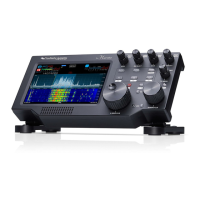FLEX-6000 Signature Series – Maestro User Guide
Page 138
Copyright 2019 FlexRadio Systems. All Rights Reserved.
A paddle set can be used as a “bug” by disabling the Iambic control. In this mode, one paddle will
key the transmitter continuously, the other will create a string of dots. In both of these
configurations, the Swap control reverses the paddle assignments.
To use a straight key, disable the Iambic control and enable the Swap control. The key should be
wired as shown in section 4.4.1, Straight Key or Paddles (KEY).
The CWU and CWL buttons alter CW tone pitch with tune direction in a similar way to upper and
lower sideband decoding.
When the Breakin button is selected, the transmitter is engaged by a key or paddle closure rather
than a PTT signal.
In the Digital section, the RTTY Mark Default control sets the default value of the RTTY IF offset when
new RTTY slice receivers are created. See section 28.2, RTTY Mode for more information about RTTY
operation.
The three sliders in the Filter Options section control the RX filter sharpness/latency for the three
mode groups, Voice (USB/LSB/AM/SAM/FM), CW and Digital (DIGU, DIGL, DFM, RTTY). The
processing time, or latency, of the digital RX filters increases as the slider is moved to the right.
Sharper filters require more processing time. In applications requiring fast turnaround of signals (e.g.
certain contest environments), faster filtering of the received signal may be more desirable than
adjacent signal rejection.
When Auto is selected for a mode group, the sharpness of the filter depends on the bandwidth of
the filter. In general, the filter gets sharper, but slower, as the bandwidth narrows. In the following,
Level 0 is the lowest latency (least sharp) and Level 3 is the highest latency (most sharp).
• DIGU/DIGL
o Bandwidth from zero to 500 Hz: Level 3
o Bandwidth from 500 to 1000 Hz: Level 2
o Bandwidth from 1000 to 2000 Hz: Level 1
o Bandwidth from 2000 to 10000 Hz: Level 0
• RTTY
o Bandwidth from zero to 400 Hz: Level 3
o Bandwidth from 400 to 1000 Hz: Level 2
o Bandwidth from 1000 to 1200 Hz: Level 0
• CW
o Bandwidth from zero to 400 Hz: Level 3

